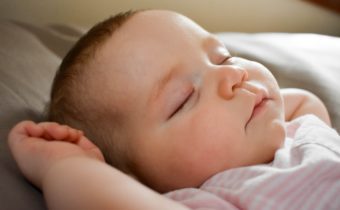Autism Spectrum Disorder (ASD) is a neuro-developmental disorder that affects one in 59 people in the US (CDC, n.d.). People with ASD present with several co-morbid conditions, one of which is a sleep disorder. Approximately 40-80% of those diagnosed with ASD suffer from some sleep form of problem (Cohen, Fulcher, Rajaratnam, Conduit, Sullivan, Hilaire, … Lockley, 2017). These problems are positively associated with repetitive and restricted behaviors, poor social interaction, and communication deficits (Hundley, Shui, and Malow, 2016). With time, sleep problems tend to worsen in children with ASD, while they tend to improve in typical children (Verhoeff, Blanken, Kocevska, Mileva-Seitz, Jaddoe, White, … and Tiemeier, 2018). While there is limited evidence for the efficacy of the pharmacological approach to treat these disorders, medications such as melatonin, antidepressants, and antipsychotics, are frequently prescribed (Relia and Ekambaram, 2018).


If the children are not able to sleep, it is likely that one or both parents are also sleep deprived. This sleep disruption can contribute to parental depression and anxiety (Giarelli and Fisher, 2016). Tilford, Payakachat, Kuhlthau, Pyne, Kovacs, Bellando, … and Frye (2015) reported that sleep problems are linked to lower health status for the children as well as their primary caregivers. Wickwire (2015) estimated that about $30 to $35 billion dollars per year are spent in the treatment of sleep related disorders. Given that sleep disorders are more prevalent in children on the spectrum than in neurotypical children (Cavalieri, 2016), it is possible that a large percentage of these expenses are dedicated to the treatment of individuals with ASD.
Total costs per year associated with an ASD diagnosis in 2011 were between $11.5 billion – $60.9 billion dollars. On average, the health costs of children diagnosed with ASD were between 4.1-6.2 times higher than the healthcare costs of typically developing children (CDC, n.d.). According to Leigh and Du (2015), by 2025 the costs associated with the treatment of ASD are expected to surpass that of ADHD and diabetes. It is hard to judge what portion of those expenses are related to sleep disorders, however, it is known that sleep disorders aggravate other autism symptoms, such as communication deficits and challenging behaviors, which in turn may lead to higher healthcare usage.

The efficacy of behavioral interventions for the treatment of sleep disorders in children with ASD is well documented, especially when these interventions involve parent training. Cavalieri (2016) reported that children of parents who received behavioral parent training showed significantly more improvement in sleep issues when compared to those who received psychoeducational training. When accounting for the costs of sleep disorders in children with ASD, it is imperative to take notice of the influence of a child’s sleep disorder on her caregivers, which may include loss of productivity, absence from work, and disruption in the family functioning. That way, when counting the costs of sleep issues in children with ASD, one has to consider the costs related to parental loss of sleep. Tilford et al. (2015) warned that not accounting for the effects of treatments on family and caregivers can lead to biases in the cost-effectiveness ratios. Their estimate for the cost-effectiveness for behavioral interventions for sleep disorder in children on the spectrum was of 0.03 quality adjusted life years (QALY), and it doubles when taking into account the effects on the family and care-givers.
To learn more about how to help your child with autism sleep better, request a consultation here.
References
Cavalieiri, A. (2016). Sleep Issues in Children with Autism Spectrum Disorder. Pediatric Nursing, (6), 169-188.
Center for disease control and Prevention (n.d.) (a) Autism Spectrum Disorder (ASD): Data and Statistics. Retrieved from: https://www.cdc.gov/ncbddd/autism/data.html
Cohen, S., Fulcher, B. D., Rajaratnam, S. M. W., Conduit, R., Sullivan, J. P., Hilaire, M. A. S., … Lockley, S. W. (2017). Behaviorally-determined sleep phenotypes are robustly associated with adaptive functioning in individuals with low functioning autism. Scientific Reports, 7(1), 14228. https://doi.org/10.1038/s41598-017-14611-6
Giarelli, E. (2016) Chapter 1- Integrating knowledge of autism with comprehensive healthcare. In Giarelli, E. & Fisher, K. (Ed.), Integrated Healthcare for people with autism spectrum disorder. Springfield, IL: Charles C Thomas Publisher, Ltd.
Hundley, R., Shui, A., & Malow, B. (2016). Relationship Between Subtypes of Restricted and Repetitive Behaviors and Sleep Disturbance in Autism Spectrum Disorder. Journal of Autism & Developmental Disorders, 46(11), 3448–3457. https://doi.org/10.1007/s10803-016-2884-4
Leigh, J., & Du, J. (2015). Brief Report: Forecasting the Economic Burden of Autism in 2015 and 2025 in the United States. Journal Of Autism & Developmental Disorders, 45(12), 4135-4139. doi:10.1007/s10803-015-2521-7
Relia, S. & Ekambaram, V. (2018). Pharmacological Approach to Sleep Disturbances in Autism Spectrum Disorders with Psychiatric Comorbidities: A Literature Review. Medical Sciences, (4), 95. https://doi.org/10.3390/medsci6040095
Tilford, J., Payakachat, N., Kuhlthau, K., Pyne, J., Kovacs, E., Bellando, J., … Frye, R. (2015). Treatment for Sleep Problems in Children with Autism and Caregiver Spillover Effects. Journal of Autism & Developmental Disorders, 45(11), 3613–3623. https://doi.org/10.1007/s10803-015-2507-5
Verhoeff, M. E., Blanken, L. M. E., Kocevska, D., Mileva-Seitz, V. R., Jaddoe, V. W. V., White, T., … Tiemeier, H. (2018). The bidirectional association between sleep problems and autism spectrum disorder: a population-based cohort study. Molecular Autism, 9, 8. https://doi.org/10.1186/s13229-018-0194-8
Wickwire, E. M. (2015). Financial Costs of Insomnia. Sleep Review, 16(1), 24–25. Retrieved from http://search.ebscohost.com/login.aspx?direct=true&db=heh&AN=100385238&site=eds-live

